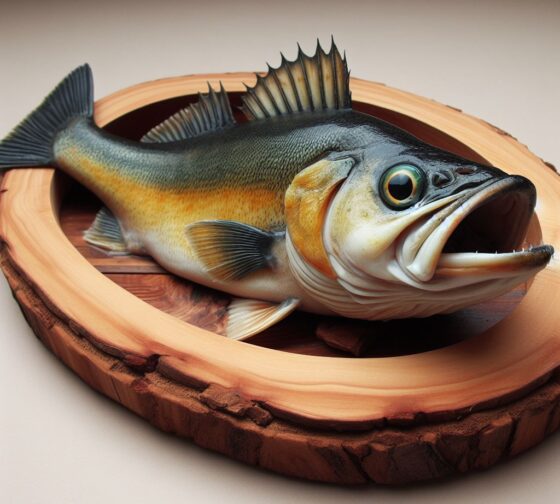Fish Taxidermy: Preserving Aquatic Memories
*We may earn a commission for purchases made using our links. Please see our disclosure to learn more.
Fish Taxidermy: Preserving the Beauty of Your Catch
Being an enthusiastic angler, I’ve come to appreciate the significance of immortalizing the beauty of a remarkable catch through the intricate craft of fish taxidermy. This unique art form extends far beyond a simple trophy on the wall; it encapsulates the thrill of the catch and the splendor of the species, preserving cherished memories for a lifetime. Let’s delve deeper into the world of taxidermy, exploring its nuances, providing comprehensive advice, and offering compelling reasons to consider this artistic preservation method.
Introduction to Fish Taxidermy
Fish taxidermy is the meticulous art of preserving and mounting a fish specimen, aiming to maintain its lifelike appearance even after it’s been removed from its natural habitat. The practice goes beyond mere preservation; it’s an art form that combines scientific knowledge and artistic skill to immortalize a prized catch.
For many anglers, a beautifully mounted fish serves as a tangible reminder of a memorable fishing expedition, triggering emotions and memories associated with that particular catch. It allows individuals to relive the exhilaration of the moment, preserving the essence of the fish in stunning detail.
Choosing the Right Fish for Taxidermy
Selecting the ideal fish specimen is a critical aspect of successful taxidermy. Several factors come into play when making this choice. Firstly, consider the size and condition of the fish. Opt for a fish that showcases its unique features, such as vibrant colors or distinct markings. Furthermore, the authenticity of the species is crucial in accurately representing the catch.
Whether it’s a prized trophy or a fish with sentimental value, the choice of specimen dictates the final outcome of the taxidermy process. A fish with noteworthy characteristics makes for a captivating display piece.
Preparation of the Fish
Before initiating the taxidermy process, ensuring the fish is in optimal condition is paramount. Proper handling and cleaning techniques are crucial to maintaining the natural appearance of the specimen post-preservation.
Begin by carefully handling the fish to prevent damage to its delicate features. Use gentle cleaning methods to remove any debris or foreign substances without compromising the integrity of the skin. Preserving the fish’s natural colors and features is vital for an authentic representation.
Taxidermy Techniques

Fish taxidermy encompasses various techniques, each with its own intricacies and applications. The choice of technique depends on factors such as the desired outcome, the species of the fish, and personal preferences.
Among the techniques employed, skin mounts and replicas are popular methods. Skin mounts involve preserving the actual skin of the fish, capturing its natural texture and coloration. Replicas, on the other hand, involve creating a precise replica of the fish, ensuring durability and longevity.
Materials and Tools Required
Executing fish taxidermy requires specific materials and tools essential for achieving a lifelike representation of the fish. These include sculpting materials, preserving agents, shaping tools, and various supplies tailored to the chosen taxidermy technique.
Sculpting materials enable the creation of molds or replicas, while preserving agents maintain the integrity of the fish’s skin and features. The proper use of tools aids in shaping and detailing, contributing to the realistic appearance of the final mount.
Finding a Professional Taxidermist
Choosing a skilled and reputable taxidermist is fundamental to the success of the taxidermy process. A proficient taxidermist possesses the expertise required to capture the essence of the fish accurately.
When seeking a taxidermist, consider their experience, portfolio of past work, and reputation within the taxidermy community. Personal recommendations or reviews from fellow anglers can also guide you in selecting a reliable professional for the task.
Maintaining and Displaying Taxidermy Fish
Caring for taxidermy fish is crucial in preserving their beauty and ensuring their longevity. Proper maintenance involves placing the mounted fish in an appropriate environment, free from direct sunlight, moisture, or extreme temperatures that could damage the specimen.
Regular dusting and occasional cleaning with mild solutions help maintain the fish’s appearance. Properly displaying the mounted fish in an aesthetically pleasing manner enhances its visual appeal and serves as a conversation starter for guests and fellow enthusiasts.
Common Mistakes to Avoid
Avoiding common pitfalls during the taxidermy process is essential to achieving a stunning result. Mishandling the fish, improper preservation techniques, or inadequate mounting procedures can significantly impact the final appearance.
Careful attention to detail, adherence to proper techniques, and seeking guidance from experienced taxidermists can help avoid potential errors that might compromise the quality of the preserved fish.
Benefits of Fish Taxidermy

Beyond being a decorative piece, taxidermy holds immense sentimental value for anglers and nature enthusiasts alike. It commemorates cherished memories associated with a remarkable catch, serving as a tangible memento of past fishing adventures.
The preserved fish becomes a symbol of achievement, pride, and appreciation for the natural beauty of aquatic life. It also provides an educational opportunity to study the intricate features and anatomy of different fish species up close.
Costs Involved in Fish Taxidermy
Understanding the expenses associated with taxidermy assists individuals in budgeting for this specialized service. The overall cost depends on various factors, including the size of the fish, the chosen taxidermy technique, and the expertise of the taxidermist.
Factors such as additional customization, complexity in mounting, or specific requests may incur additional charges. It’s advisable to discuss pricing details with the taxidermist beforehand to avoid any surprises.
Environmental and Ethical Considerations
The practice of fish taxidermy raises concerns regarding its environmental impact and ethical considerations. As responsible anglers and conservationists, it’s essential to address these concerns.
Ethical taxidermists often acquire their specimens ethically, either through legal catches or from sustainably sourced sources. They follow guidelines and regulations to ensure the preservation of fish does not harm natural ecosystems or endanger species.
Environmental considerations include the use of eco-friendly materials and methods in taxidermy processes to minimize any adverse impact on the environment.
Conclusion
Fish taxidermy stands as a tribute to the passion for fishing, transforming a fleeting moment into a lasting memory. It encapsulates the beauty of aquatic life, preserving the essence of a prized catch for generations to admire and cherish. Through meticulous techniques and an artistic touch, taxidermy immortalizes the thrill of the catch, offering a tangible connection to cherished fishing adventures.




